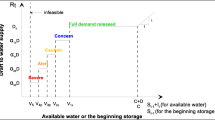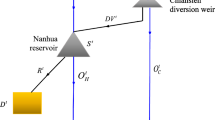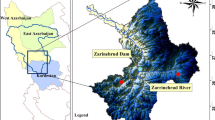Abstract
This study aims to construct two hedging policies based on current storage and two auxiliary factors (past storage trend and future standardized streamflow index (SSI) and compare the effects on reservoir performance in terms of shortage characteristics (maximum single-period shortage ratio, total shortage ratio, average water shortage per shortage period, and risk) during droughts. The proposed approach is applied to the Nanhua Reservoir located in southern Taiwan. The results reveal that Model S (demand-based rule curves associated with fuzzified storage) efficiently improves shortage characteristics during droughts and outperforms Model C (current operation). Further improvements are obtained by incorporating past storage trends (Model STs: Model S with different periods of past storage trends) and future SSIs (Model SHs: Model S with different time-scale SSIs) into Model S. Exactly known SSIs in Model SHs derive optimistic hedging policies that have fewer less-than-1 rationing coefficients and significantly reduce shortage duration and total deficits. In contrast, Model STs lack future inflow information and lead to conservative hedging policies, which have early hedging and effectively decrease the maximum single-period water shortage. The effects of past storage trends and future SSIs on shortage characteristics decrease with longer periods since models with short-term information effectively capture the inherent variations and derive more effective hedging policies. According to the overall objective, Model SHs generally outperform Model STs, models with short-term information outperform the long-term models, and all the proposed optimization models outperform the current operation.





Similar content being viewed by others
Data Availability
Streamflow data used in this study are provided from Water Resources Agency, Taiwan (https://www.wra.gov.tw).
References
Adeloye AJ, Dau QV (2019) Hedging as an adaptive measure for climate change induced water shortage at the pong reservoir in the Indus Basin Beas River, India. Sci Total Environ 687:554–566
Ahmadianfar I, Zamani R (2020) Assessment of the hedging policy on reservoir operation for future drought conditions under climate change. Clim Chang 159(2):253–268
Ahmadianfar I, Adib A, Taghian M (2016) Optimization of fuzzified hedging rules for multipurpose and multireservoir systems. J Hydrol Eng 21(4):05016003
Ahmadianfar I, Adib A, Taghian M (2017) Optimization of multi-reservoir operation with a new hedging rule: application of fuzzy set theory and NSGA-II. Appl Water Sci 7(6):3075–3086
Ashofteh PS, Bozorg-Haddad O, Loaiciga HA (2017) Logical genetic programming (LGP) development for irrigation water supply hedging under climate change conditions. Irrig Drain 66(4):530–541
Ashrafi SM, Mostaghimzdeh E, Adib A (2020) Applying wavelet transformation and artificial neural networks to develop forecasting-based reservoir operating rule curves. Hydrol Sci J 65(12):2007–2021
Cancelliere A, Ancarani A, Rossi G (1998) Susceptibility of water supply reservoir to drought conditions. J Hydrol Eng 3(2):140–148
Chang JX, Guo AJ, Wang YM, Ha YP, Zhang R, Xue L, Tu ZQ (2019) Reservoir operations to mitigate drought effects with a hedging policy triggered by the drought prevention limiting water level. Water Resour Res 55(2):904–922
Cheng WM, Huang CL, Hsu NS, Wei CC (2017) Risk analysis of reservoir operations considering short-term flood control and long-term water supply: a case study for the Da-Han Creek basin in Taiwan. Water 9(6):424
Ding W, Zhang C, Cai X, Li Y, Zhou H (2017) Multiobjective hedging rules for flood water conservation. Water Resour Res 53(3):1963–1981
El Harraki W, Ouazar D, Bouziane A, Hasnaoui D (2021) Optimization of reservoir operating curves and hedging rules using genetic algorithm with a new objective function and smoothing constraint: application to a multipurpose dam in Morocco. Environ Monit Assess 193:196
Felfelani F, Movahed AJ, Zarghami M (2013) Simulation hedging rules for effective reservoir operation by using system dynamics: a case study of Dez reservoir, Iran. Lake and Reservoir Management 29(2):126–140
Hirsch RM, Slack JR, Smith RA (1982) Techniques of trend analysis for monthly water quality data. Water Resour Res 18(1):107–121
Hu T, Zhang XZ, Zeng X, Wang J (2016) A two-step approach for analytical optimal hedging with two triggers. Water 8(2):52. https://doi.org/10.3390/w8020052
Hwang CL, Yoon K (1981) Multiple attribute decision making: methods and applications. Springer-Verlag, Berlin
Ilich N (2011) Improving real-time reservoir operation based on combining demand hedging and simple storage management rules. J Hydroinf 13(3):533–544
Ji Y, Lei X, Cai S, Wang X (2016) Hedging rules for water supply reservoir based on the model of simulation and optimization. Water 8(6):249
Jin Y, Lee S (2019) Comparative effectiveness of reservoir operation applying hedging rules based on available water and beginning storage to cope with droughts. Water Resour Manag 33(5):1897–1911
Karamouz M, Araghinejad S (2008) Drought mitigation through long-term operation of reservoirs: case study. J Irrig Drain Eng 134(4):471–478
Kumar K, Kasthurirengan S (2018) Generalized linear two-point hedging rule for water supply reservoir operation. J Water Resour Plan Manag 144(9):04018051
Li Y, Ding W, Chen X, Cai X, Zhang C (2020) An analytical framework for reservoir operation with combined natural inflow and controlled inflow. Water Resour Res 56(8):e2019WR025347
Men B, Wu Z, Liu H, Li Y, Zhao Y (2019) Research on hedging rules based on water supply priority and benefit loss of water shortage - a case study of Tianjin, China. Water 11(4):778
Peng Y, Chu JG, Peng A, Zhou H (2015) Optimization operation model coupled with improving water-transfer rules and hedging rules for inter-basin transfer-supply systems. Water Resour Manag 29(10):3787–3806
Shiau JT (2011) Analytical optimal hedging with explicit incorporation of reservoir release and carryover storage targets. Water Resour Res 47(1):W01515. https://doi.org/10.1029/2010WR009166
Shiau JT, Lee HC (2005) Derivation of optimal hedging rules for a water-supply reservoir through compromise programming. Water Resour Manag 19(2):111–132
Shiau JT, Hung YN, Sie HR (2018) Effects of hedging factors and fuzziness on shortage characteristics during droughts. Water Resour Manag 32(5):1913–1929
Shih JS, ReVelle C (1994) Water-supply operations during drought: continuous hedging rule. J Water Resour Plan Manag 120(5):613–629
Shih JS, ReVelle C (1995) Water supply operations during drought: a discrete hedging rule. Eur J Oper Res 82(1):163–175
Taghian M, Rosbjerg D, Haghighi A, Madsen H (2014) Optimization of conventional rule curves coupled with hedging rules for reservoir operation. J Water Resour Plan Manag 140(5):693–698
Telesca L, Lovallo M, Lopez-Moreno I, Vicente-Serrano S (2012) Investigation of scaling properties in monthly streamflow and standardized Streamflow index (SSI) time series in the Ebro basin (Spain). Physica A: Statistical Mechanics and its Applications 391(4):1662–1678
Wan W, Zhao J, Wang J (2019) Revisiting water supply rule curves with hedging theory for climate change adaptation. Sustainability 11(7):1827
Wang H, Liu J (2013) Reservoir operation incorporating hedging rules and operational inflow forecasts. Water Resour Manag 27(5):1427–1438
Wang J, Hu T, Zeng X, Yasir M (2018) Storage targets optimization embedded with analytical hedging rule for reservoir water supply operation. Water Sci Technol Water Supply 18(2):622–629
Wang J, Cheng C, Wu X, Shen J, Cao R (2019) Optimal hedging for hydropower operation and end-of-year carryover storage values. J Water Resour Plan Manag 145(4):04019003
Xu B, Zhong PA, Huang Q, Wang J, Yu Z, Zhang J (2017) Optimal hedging rules for water supply reservoir operations under forecast uncertainty and conditional value-at-risk criterion. Water 9(8):568
Xu Z, Cai X, Yin X, Su M, Wu Y, Yang Z (2019) Is water shortage risk decreased at the expense of deteriorating water quality in a large water supply reservoir? Water Res 165:114984
Xu B, Huang X, Zhong PA, Wu Y (2020) Two-phase risk hedging rules for informing conservation of flood resources in reservoir operation considering inflow forecast uncertainty. Water Resour Manag 34(9):2731–2752
You J, Cai X (2008) Hedging rule for reservoir operations: 1. A theoretical analysis. Water Resour Res 44(1):W01415. https://doi.org/10.1029/2006WR005481
Zhang C, Ding W, Li Y, Meng F, Fu G (2019) Cost-benefit framework for optimal design of water transfer systems. J Water Resour Plan Manag 145(5):04019009
Zhao Q, Cai X, Li Y (2020) Algorithm design based on derived operation rules for a system of reservoirs in parallel. J Water Resour Plan Manag 146(5):04020024
Acknowledgements
Financial support for this study was graciously provided by the Ministry of Science and Technology, Taiwan, ROC (MOST 107-2221-E-006-031).
Code Availability
Not applicable.
Funding
This research was funded by Ministry of Science and Technology, Taiwan, ROC, grand number MOST 107–2221-E-006-042.
Author information
Authors and Affiliations
Contributions
Conceptualization: J.T. Shiau; Methodology: J.T. Shiau; Formal analysis and investigation: H.H. Wen, I.W. Su; Writing – original draft preparation: J.T. Shiau; Writing – review and editing: J.T. Shiau; Funding acquisition: J.T. Shiau.
Corresponding author
Ethics declarations
Conflict of Interest
The authors declare no potential conflicts of interest.
Additional information
Publisher’s Note
Springer Nature remains neutral with regard to jurisdictional claims in published maps and institutional affiliations.
Rights and permissions
About this article
Cite this article
Shiau, JT., Wen, HH. & Su, IW. Comparing Optimal Hedging Policies Incorporating Past Operation Information and Future Hydrologic Information. Water Resour Manage 35, 2177–2196 (2021). https://doi.org/10.1007/s11269-021-02834-2
Received:
Accepted:
Published:
Issue Date:
DOI: https://doi.org/10.1007/s11269-021-02834-2




